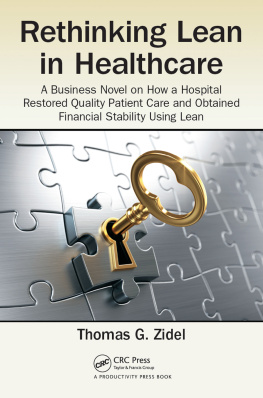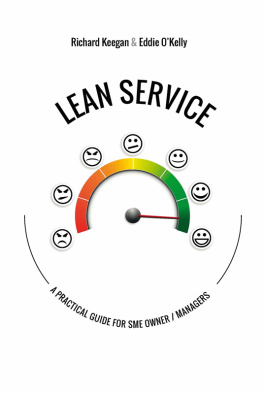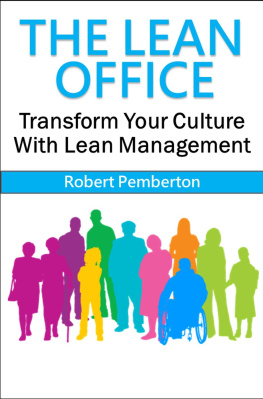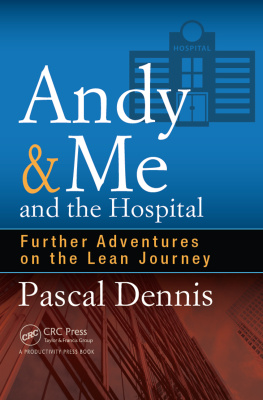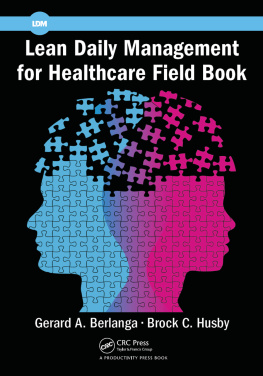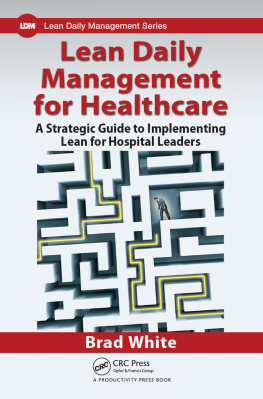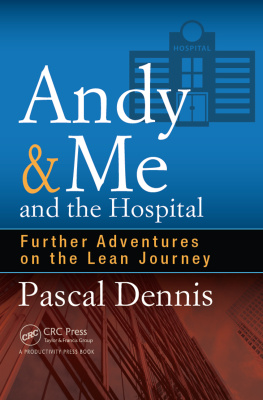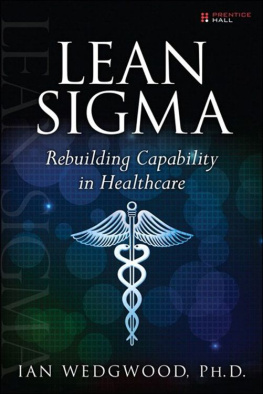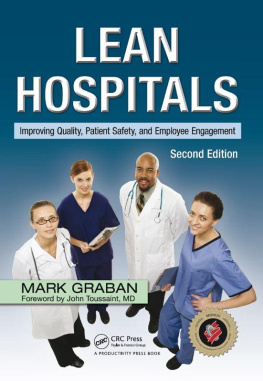CONTENTS
Page List
Guide

Rethinking Lean in Healthcare
A Business Novel on How a Hospital Restored Quality Patient Care and Obtained Financial Stability Using Lean
Rethinking Lean in Healthcare
A Business Novel on How a Hospital Restored Quality Patient Care and Obtained Financial Stability Using Lean
Thomas G. Zidel

CRC Press
Taylor & Francis Group
6000 Broken Sound Parkway NW, Suite 300
Boca Raton, FL 33487-2742
2017 by Thomas G. Zidel
CRC Press is an imprint of Taylor & Francis Group, an Informa business
No claim to original U.S. Government works
Printed on acid-free paper
Version Date: 20160113
International Standard Book Number-13: 978-1-4987-7129-0 (Paperback)
This book contains information obtained from authentic and highly regarded sources. Reasonable efforts have been made to publish reliable data and information, but the author and publisher cannot assume responsibility for the validity of all materials or the consequences of their use. The authors and publishers have attempted to trace the copyright holders of all material reproduced in this publication and apologize to copyright holders if permission to publish in this form has not been obtained. If any copyright material has not been acknowledged please write and let us know so we may rectify in any future reprint.
Except as permitted under U.S. Copyright Law, no part of this book may be reprinted, reproduced, transmitted, or utilized in any form by any electronic, mechanical, or other means, now known or hereafter invented, including photocopying, microfilming, and recording, or in any information storage or retrieval system, without written permission from the publishers.
For permission to photocopy or use material electronically from this work, please access www.copyright.com (http://www.copyright.com/) or contact the Copyright Clearance Center, Inc. (CCC), 222 Rosewood Drive, Danvers, MA 01923, 978-750-8400. CCC is a not-for-profit organization that provides licenses and registration for a variety of users. For organizations that have been granted a photocopy license by the CCC, a separate system of payment has been arranged.
Trademark Notice: Product or corporate names may be trademarks or registered trademarks, and are used only for identification and explanation without intent to infringe.
Library of Congress Cataloging-in-Publication Data
Names: Zidel, Thomas G., 1949-, author.
Title: Rethinking lean in healthcare : a business novel on how a hospital restored quality patient care and obtained financial stability using lean / Thomas G. Zidel.
Description: Boca Raton : CRC Press/Taylor & Francis, 2017. | Includes index.
Identifiers: LCCN 2016000989 | ISBN 9781498771290 (pbk. : alk. paper)
Subjects: | MESH: Hospital Administration | Quality of Health Care | Quality Assurance, Health Care--methods | Efficiency, Organizational | Quality Improvement
Classification: LCC RA971 | NLM WX 150.1 | DDC 362.11068--dc23
LC record available at http://lccn.loc.gov/2016000989
Visit the Taylor & Francis Web site at
http://www.taylorandfrancis.com
and the CRC Press Web site at
http://www.crcpress.com
Contents
The Joint Commission introduced American hospitals to quality assurance in the 1980s and to quality improvement a few years later. It also proffered its plan, do, check, act cycle as a preferred method for carrying out quality improvement activitiesa method that is still widely used at present.
Well before 2000, hospitals also began to look to industry for a more comprehensive and effective approach to quality improvement and discovered Lean and Lean/Six Sigma, the methodologies through which American industries were improving their quality and enhancing their competitiveness in their home and world markets. Hospitals and health systems began to adopt both methodologies.
It has been a long process. Healthcare has been predictably slow to adopt quality improvement strategies from industry (patients are not widgets, you know) despite numerous well-documented, remarkable successes. Moreover, the jargon of Lean and the Japanese terms used to express its fundamental characteristics can be daunting to American hospital staff and leaders alike.
Enter Rethinking Lean in Healthcare. This slim book reviews and explains the principles and terms that are used in Lean for healthcare in a manner that is suitable for first-timers or those who need a refresher. It does so through the fictional account of a troubled (read, losing money) hospital with a somewhat hapless president and senior management staff who have learned, on their own, an important lessonyou cannot make a hospital profitable simply by cutting expenses. They are beginning to understand it but do not know what to do about it. In an intense and career-saving two-week period, however, they review their prior failures and realize that they have in front of them a potential solution to their quality problems, profitability, and dreadful staff morale: Lean for healthcare.
In a manner, this book reminds me of Berton Roueches classic, Eleven Blue Men. Roueche introduced generations of physicians and nonmedical personnel to modern epidemiology through a series of engaging mystery stories that were published first in The New Yorker (19471953) and then in a compilation. The book remains enjoyable at present.
Like Roueches stories, Rethinking Lean in Healthcare is a mystery. Will the hospital president survive? Indeed, can the hospital survive? What went wrong when the hospital tried Lean years earlier, and what will be different this time? What new intrigues will the team face from resistors? With his typical clarity, Zidel neatly answers all these questions while explaining how and why Lean works in healthcare. He understands how healthcare personnel struggle with certain aspects of Lean and uses his story to address those struggles in a manner that is accessible to all readers.
Rethinking Lean in Healthcare will be enjoyed by healthcare personnel and others alike while helping to disseminate an understanding of this powerful quality improvement method.
Richard Weinberg, MD CPE
Corporate director, pharmacy services, occupational medicine,
occupational and environmental safety and ergonomics,
Atlantic Health System, retired
My initial introduction to Lean manufacturing was during my tenure as a project engineer for an American multinational conglomerate in the aerospace industry. I had studied the works of Frederick Taylor, W. Edwards Deming, and Joseph Juran, but the Toyota Production System (Lean) seemed to encompass all of the principles preached by these men, and more. I became so interested in Lean that I left engineering to go and work in manufacturing. I learned from the consultants, was hired by the company, and attended countless Lean conferences. I was excited to put these principles to work. My initial experiences with Lean were not what I had hoped for. Even though the tools and principles of Lean, when applied to processes, reduced errors, increased production, improved work flow, eliminated excess inventory, and enhanced the quality of the product, the gains were not sustainable. This circumstance was extremely frustrating. I spoke with consultants and raised the question of sustainability at conferences, but the answers I received were never satisfactory. I read books on change management and experimented with the philosophies, but to no avail. The more I tried, the stouter the resistance. The company I was working for was spending huge sums of money in its attempt to become a Lean enterprise, but they were failing miserably. I knew something was missing but could not put my finger on it. I left manufacturing when I was offered an opportunity to implement Lean in healthcare. I quickly identified huge opportunities.

